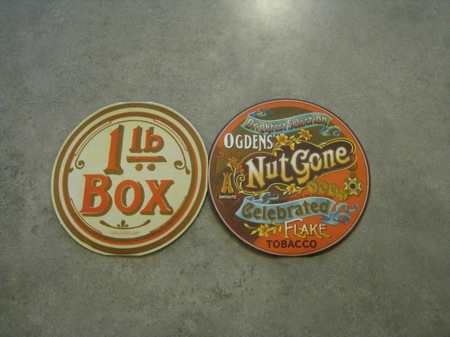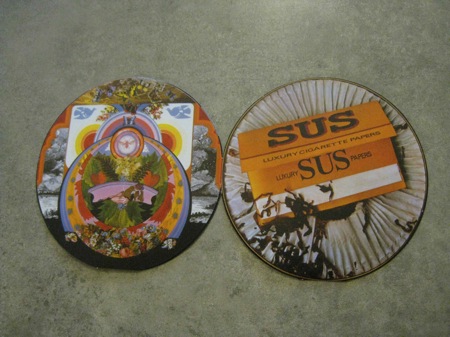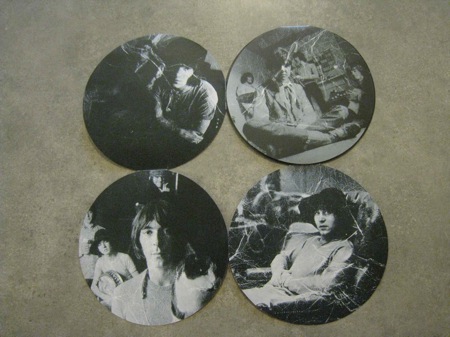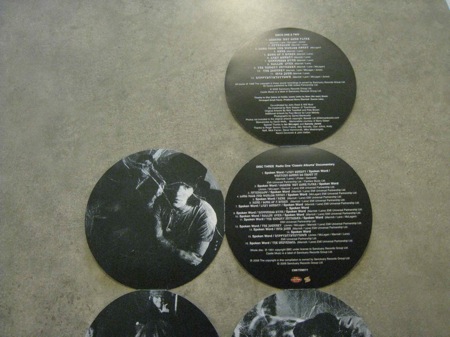Given the packaging, you might be inclined to dismiss the album as a gimmick, given the identity and chart success of the Small Faces you might be inclined to dismiss them as teenybopper lightweights, but a close examination of the Small Faces’ output reveals a very classy R&B based outfit. This was their finest hour...
Rear View: The Small Faces "Ogdens' Nut Gone Flake"

It took a remark in a Facebook conversation from long lost acquaintance Bloke Nicknamed Rubbish By JB to remind me of a glaring omission from the list of Rear View projects that was glaring enough to be addressed ASAP.
In some ways, regardless of labelling, this is a Retrospective since it's a case of looking back over a relatively brief career from the lofty heights of a major but largely ignored masterpiece.
And in some ways, Ogden's Nut Gone Flake is one of those watershed landmarks that separate the classic singles era from around 1965 to 1969 from the album-dominated years that followed.
I've remarked on the musical landscape of the mid-sixties before, and will doubtless return to the subject in the future, but there are a couple of salient points that need to be reiterated before we can get around to looking at this classic album as a landmark watershed (or whatever other term you care to apply).
For a start we're talking a musical era that was dominated, at least as far as the teenage punter was concerned, by the interaction of the charts, the radio and the dance floor.
Second, as far as recorded music was concerned, if you wanted to play a song it was a case of going over to the record player and physically putting the disk into the machine. Sure, if it had a built-in stacker/changer you could take a number of disks, pile them up and let them rip, but we're talking about an environment that's a million miles removed from loading a couple of thousand tracks into your MP3 player, selecting shuffle and hitting the forward button if what's playing doesn't float your current existential boat.
Third, as far as the industry (by which we mean the conjunction of artist management, record companies, music publishers and associated hangers on) was concerned, success was largely based around the interaction between the quantity of product you could generate and the market's ability to absorb it.
Here's how I see it anyway.
Everything was based around the hit single, which was everybody's bread and butter and needed to be delivered at least three or four times a year in a career that was only going to continue if you could keep on delivering chart hits.
And it was an incredibly competitive market place. With the likes of The Beatles and the Stones sitting on the top of the heap, and a second tier (we're specifically talking the British market here) made up of the likes of The Who, The Kinks, The Animals, The Hollies, The Yardbirds and Manfred Mann, all of whom were delivering pretty consistently over the time frame we're looking at, it wasn't going to be an easy nut to crack.
Which, of course, explains the number of one hit wonders who shot to temporary prominence. It wasn't easy to deliver something that would make the audience stop, sit up and take notice, and having done it once it wasn't always easy to do it again.
In that environment, something like the Small Faces third single Sha-La-La-La-Lee, written by Kenny Lynch and Mort Shuman, with its Picked her up on a Friday night opening line was a natural fit. The band might have hated the song, and Lynch may have been a relative lightweight, but Shuman was coming off the New York-based writing partnership with Doc Pomus that produced Teenager in Love, Save The Last Dance For Me, Little Sister, His Latest Flame, Viva Las Vegas and Sweets for my Sweet.
Their August 1965 debut single Whatcha Gonna Do About It (tune by Steve Marriott and Ronnie Lane, based on Solomon Burke's Everybody Needs Somebody to Love, words by Ian Samwell) had charted respectably, the second, I've Got Mine, also written by singer Steve Marriott and bass player Ronnie Lane, had tanked after it was released in November, so it was a case of outside help or, potentially, the scrap heap when manager Don Arden was looking for a follow up in January 1966.
A miss with Hey Girl four months later was followed by All Or Nothing, a chart topper that could have shot them right up into the big time except for a drug conviction (keyboard player Ian McLagan 13 November 1967 at Heathrow airport en route to Greece for a holiday) that ruled out a US tour with the Lovin' Spoonful and the Mamas & the Papas.
It wasn't too long after All Or Nothing before the band split with manager Arden and record label Decca, signing with former Stones manager Andrew Loog Oldham's Immediate label, resulting in a situation where the two labels were simultaneously releasing competing product. A Decca album From The Beginning combining old hits and previously unreleased recordings and Immediate's Small Faces both appeared in June 1967. Messy...
I have vague memories of looking at both albums when they came out, scratching my head and giving both the flick pass. In the case of the Decca album, I'd guess it was a combination of lack of funds and a majority of tracks I'd never heard of along with the two big singles, while the same lack of funds and anything familiar would have ruled the Immediate release out of contention.
These days, of course, you can pick up both with bonus tracks, and a glance at my preferred on-line seller revealed reasonably priced (<$12) copies of both and having had a chance to run through both I have to admit I'm more impressed by the Immediate offering, and not just because what lobbed on the doorstep was a two-disk set (material in stereo on the first disk largely reprised in mono on the second) with forty-eight tracks. Not too shabby for $11.97!
Still, while From the Beginning might have been an exercise in emptying the vaults and causing maximum disruption to the rival product it still ain't too shabby. Admittedly I didn't really need the album, having already got all the Decca hit singles (What'cha Gonna Do About It, Sha-La-La-La-Lee, Hey Girl, All Or Nothing and My Mind's Eye) on an earlier Faces compilation, but from the opening reworking of Del Shannon's Runaway it's a reasonably interesting collection, largely drawn from the band's stage repertoire over the preceding year or two.
There's material from both versions of the lineup, with keyboard duties attended to by former member Jimmy Winston (interesting take on the Marvin Gaye cover Baby, Don't You Do It with a Winston vocal) and his replacement Ian McLagan. Other covers include readings of Don Covay's Take This Hurt Off Me and Smokey Robinson and the Miracles' You've Really Got A Hold On Me that underline what a great R&B vocalist they had in Mr Marriott.
Other tracks, like My Way Of Giving (rushed out as a single by Decca while it was still at the demo stage, an act that was largely responsible for the move to Immediate) were more or less works in progress (Tell Me Have You Ever Seen Me may well have actually been finished, but was re-recorded for the new label) or demos for material handed over to other singers (My Way of Giving was done by Chris Farlowe and re-recorded for the new label). There's a Booker T & the MGs style instrumental (Plum Nellie), a couple of interesting bits of semi psychedelia (Yesterday, Today, and Tomorrow and That Man) a handful of dance floor numbers and the reissue comes with around a half dozen alternative tracks and BBC recordings.
Taken all together, while it mightn't have quite been in the same league as the classic albums from 1967 (The Doors, Something Else By The Kinks, or Disraeli Gears to name a couple of less obvious suspects from a very strong year) it's not that far behind.
And, remember, it's the leftovers after a label switch. When you look at it in that light (not that the band wanted you to back then, going as far as discouraging the punters from investing in a copy in the advertising for the Immediate Small Faces) it, even at the time you could have done far worse...
The conflicting philosophies behind those two albums, however, reflects some of the changes the music industry was going through in the late sixties.
Up to this point everything was based around the hit single in a market environment that was significantly different to the one that operates today. For a start chart success was largely based on sales rather than some algorithm based on a mixture of sales, airplay and the number some market researcher started with.
In the British context radio airplay might have been a significant influence but it probably didn't matter as much as the number of units that the record company could actually move. In today's environment broadcast royalties are a significant income stream for artists, publishers and labels, but in mid- to late-sixties Britain they probably weren't such a big deal since the pirate stations probably didn't pay them (at least I assume they didn't, I may well be wrong) and once the pirates had been shut down their replacement, BBC Radio One, had severe restrictions on what they termed needle time, with the rest of the broadcast content coming in the form of covers played by working musicians or sessions specially recorded for the BBC by the artists themselves.
A hit single, or preferably a string of them, opened the way to all the other little earners that generated a substantial income, determining the band's position on the bill on a package tour, maximising exposure on music-based TV shows, getting the act a slot on a TV variety show…
And the hit single, in the standard business model generated income and royalties for the artist, the record company and associated hangers-on based on the number of times you could get the punters to buy the actual song.
First, of course, there was the single. The record company then could, and often did, take the song, add another three (preferably including another single) and repackage them as a four track EP (Extended Play). That didn't always happen, particularly in cases where there wasn't much recorded material to work with, but once you had more than a dozen tracks there was the possibility of an album (or LP Long Player), and if there was a relatively lengthy career you could squeeze in a Greatest Hits or Best of package as well.
So with that Decca From The Beginning Small Faces album you can see the record label and the former management operating in milk it for all it's worth mode.
At the same time there was a new, hipper, business model emerging, based on the avoidance of repetition, and you can see it kicking in with the Immediate album. In this setting you didn't put the hit single on the album, dismissing that practice as an exercise in ripping off the fans.
This model tended to be favoured by groups that wrote their own material, since it meant that they were generating maximum royalties as they had a go at the premium end of the market.
You can see this kind of thing emerging with the likes of the Rolling Stones Between the Buttons, Where the preceding album, Aftermath, included Mother's Little Helper, Lady Jane, Under My Thumb and Out of Time, the twelve tracks on the British Between the Buttons didn't even contain the B-side of a single.
Other examples of the same phenomenon that could be cited include Fresh Cream, Jimi Hendrix's Are You Experienced? and The Who's A Quick One, and the trend was strengthened by the Beatles' failure to include Penny Lane, Strawberry Fields Forever or All You Need Is Love on Sgt Pepper.
After a moderate hit with their first Immediate single Here Come the Nice which grooved along nicely without hitting any heights as Marriott looked forward to the impending arrival of some speed (a reference they managed to sneak past the broadcast authorities), and the relatively modest selling album the band hit the top of the charts with Itchycoo Park, followed it with the superb, but marginally less commercial Tin Soldier and just missed #1 in the U.K. singles chart with Lazy Sunday.
Those three singles brought their own issues. Itchycoo Park, with the it's all too beautiful chorus might have gone down well with the public, and Lazy Sunday went down a treat with the general public but as far as the band were concerned the novelty soon wore thin.
Commercial or pop success was all very well, and it certainly delivered substantial fringe benefits apart from the money and the lifestyle, something the Faces, with the shared house at 22 Westmoreland Terrace, Pimlico and an eye on the latest Carnaby Street threads were only too happy to accept. Being pursued by hordes of screaming teenage girls might have been a major pain but there were certain side benefits when it came to getting a shot away.
There was, on the other hand, the question of peer group recognition, and a desire to avoid being labelled a teenybopper pop outfit, the sort of thing that delivered what I'm inclined to label the prog rock impulse, that point where you set out to amaze and impress your peer group with the quality of your writing, your instrumental chops and vocal dynamics and your (or rather your producer and sound engineer's) mastery of the recording studio,
One short cut to peer group approval and a rise above common or garden pop sensibility was the nod and a wink substance reference, the reference to the dealer in Here Comes the Nice, or the I got high bit in Itchycoo Park. Naughty schoolboy see what we can get away with, perhaps, but when you're looking for peer group recognition every bit of added credibility helps, doesn't it?
You can see the quality of writing side of things emerging on the Immediate Small Faces, along with the little musical bits that'll attract nods and a nice from the cognoscenti. The start of Feeling Lonely, Up the Wooden Hills to Bedfordshire (the title gets the nod for a start, and the When you're slipping into sleep/That's the time to unwind) and Eddie's Dreaming (named for Georgie Fame's trumpeter, who appears on the track) being prime examples.
But in the wake of Revolver, Sgt Pepper, Pet Sounds, The Who Sell Out, Are You Experienced and Disraeli Gears delivering hit singles with a nod and a wink was all very well, but you needed to demonstrate the ability to deliver over an album. In an environment where experimentation was a key element in delivering a killer album anything that helps your effort stand out from the crowd was going to be helpful.
Which, when we start looking at Ogden's Nut Gone Flake, starts with the packaging, doesn't it? You start with the title, and the nod and a wink reference to what you're going to be mixing with the tobacco as you roll your own, and the one pound box on the back. For those unfamiliar with the old imperial measures, the sixteen ounce pound was the equivalent of about half a kilogram and, in case you were wondering, you (or rather they, I've never bought dope, so I'm working on what I've read and been told, you understand) bought your deal of grass by the ounce.

The circular sleeve mightn't have been the most practical enclosure for the vinyl, but it definitely stood out from the pack, and was a parody of Ogdens' Nut-brown Flake, a Liverpool-produced brand of tobacco dating back to 1899, hence the Victoriana packaging.

Open it out and you've got the inside of the tobacco tin, with the pack of SUS Luxury Cigarette Papers, nudge, nudge, wink wink on the right and a bit of period psychedelia on the left. Fold it out again and you've got the group portrait bit, all the while presenting something totally devoid of mundane items like track listings and assorted credits.

My original vinyl copy of the album had the packaging fall apart after repeated handling, and the reissue I bought down the track had the original cover printed on the regulation white twelve inch square cardboard enclosure, so I've got no way of knowing (and I definitely can't recall after forty-four years) whether the credits under the Ronnie Lane panel on my three CDs in a tin reissue were there in the original.

There are other bits and pieces thrown into that reissue, but let's stick to the original, shall we?
Setting the packaging to one side, it's the music that counts, and the music's very much a tale of two sides. From the opening instrumental title track, the Tin Soldier-clone Afterglow, Ian McLagan's Long Ago and Worlds Apart you've got an interesting collection of styles before you hit the Cockney docklands knees up of Rene (the dockers' delight, nudge, nudge), the proto-heavy Song of a Baker and the hit single in Lazy Sunday to round off the side. It's an impressive array of songs over a range of genres that ticks all the boxes when it comes to impressing the audience and your peers with impress your peer group with quality of writing, instrumental chops and vocal dynamics, with great R&B tinged vocals from Marriott, charming efforts from Lane and McLagan,
As a collection of songs it's a match for just about anything that came out around the same period.
But when you're looking for something that stands out from the pack, Side Two, subtitled Happiness Stan definitely does that, thanks to the inter-track vocal gobbledegook from 'Professor' Stanley Unwin after the band's original choice, Spike Milligan, was ruled out by his agent. As far as the actual songs were concerned, much of the side was written on hired cabin cruiser excursions on the Thames with wives, guitars and tape recorders to keep track of the writing.
As a period piece, Happiness Stan and his quest for the other half of the moon and dangly could have got pretty tired rather quickly, but provided you don't play the hell out of it, Unwin's verbal contortions continue to please. They've got their own charm, provided you don't overdo it.
As far as the songs are concerned, Happiness Stan introduces us to the protagonist, disturbed by the waxing and waning of the moon (the other half of the moon and dangly) and determined to do something about it. Tell everybody I'm gonna find it/There ain't nothing gonna stop me is Rollin'Over's statement of intent. The Hungry Intruder delivers the means to investigate the mystery, the fly who knows someone who'll explain the mystery if only he was big enough to take Stan there.
Fortunately, Stan has the power to transform all the flies in the world into one fly, and The Journey delivers him into the presence of Mad John, and his journey has lasted long enough for the moon to resume its original shape. John advises Stan of the very meaning of life itselft, namely Life is just a bowl of All-Bran (as in you wake up every morning and it's there, a rather Zen take on the matter) in Happydaystoytown.
The problem was, however, that while the album worked on record, it wasn't the sort of thing you could deliver on stage, though they did manage a mimed run through Song of a Baker and the whole of Side Two on the BBC's Colour Me Pop in June 1968.
When Marriott's follow-up to Lazy Sunday, the rather charming The Universal, failed to chart he started looking for other avenues, wanting to bring Peter Frampton into the line up, presumably to work the same sort of twin guitar territory he went on to explore with Frampton in the original incarnation of Humble Pie. It was, after all, that back to the roots era of The Beatles' Lady Madonna, Creedence Clearwater Revival and Music from Big Pink.
In that light you can make a pretty fair case for Ogdens as not just a classic album but an achievement that represents something very close to the apogee of psychedelia that still works rather well forty-plus years after that particular era.
Works, in fact, in ways that many of its contemporaries don't.

